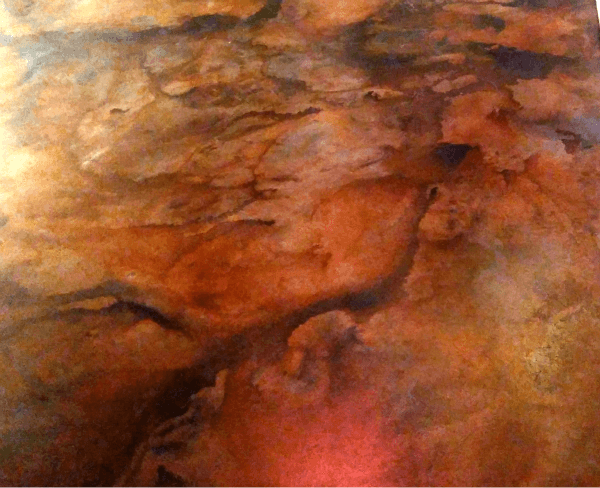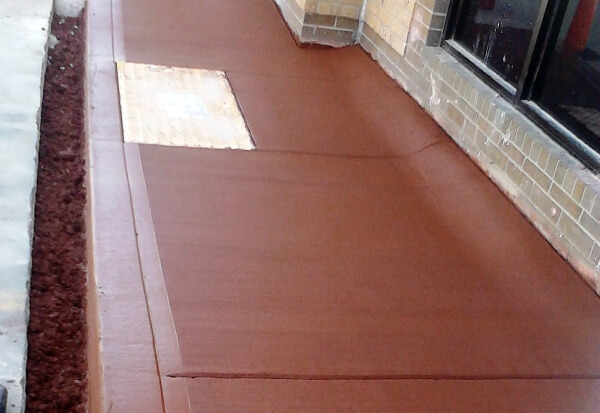Concrete Contractors
Kansas City
Concrete Acid Stain Tips
How Does Concrete Acid Stain Work?
Here are a few concrete acid stain tips to help you understand a little more about the acid staining process.
Concrete floor acid stain is not a paint. It is a chemically reactive stain. After application of acid-stain to a concrete surface, the acidic metallic ion (mineral) particles in the acid stain chemically react with the free alkali (lime) particles in the cement.
The metal oxide colors in the acid stain are what create the colored, variegated, translucent visual effects. These metallic oxide (colored) particles become a permanent part of the concrete slab.
Acid Stained Concrete vs. Colored Concrete
Both acid stained concrete and colored concrete are available in different color choices.
The difference between acid-stained concrete and colored concrete is that concrete acid stain is only applied to the top surface of the existing concrete slab.
Colored concrete is colored when the concrete is in the Ready-Mix truck, before the concrete is poured. Colored concrete produces one uniform color throughout the entire slab of concrete.
Acid stained concrete will have multi-shades of darker and lighter translucency, depending upon several concrete variables, which are discussed, below.
Acid Stained Concrete Floor
 Acid Stained Concrete Floor - Multiple Acid Stain Colors Were Used to Create a Marbled Design
Acid Stained Concrete Floor - Multiple Acid Stain Colors Were Used to Create a Marbled DesignColored Concrete
Acid-Stain Variables
There are many variables which affect an acid-etched concrete surface’s final color appearance, some of which are the concrete’s texture, age, hardness, and the dilution ratio of the acid-etching stain.
Concrete Hardness and Chemical Composition
Hardness Test – The decorative concrete contractor may perform a hardness test before choosing which products to apply for optimum long term performance.
Slab Density can be very hard, hard, medium hard, medium, soft, or very soft. Softer concrete is more porous, and will accept color more quickly. Harder concrete is denser, and may not accept the chosen color as easily.
Concrete Composition - Concrete can have a different composition in different parts of the country due to different materials that are available, such as fly ash or other additives used in the concrete mix. Concrete can also be different between two different truck loads from the same concrete plant.
Concrete hardness is also affected when additional water is added to the mix to prolong its working time. Weather conditions such as temperature, rain, snow and humidity when the concrete was poured affect how fast it cured, which all affect how it hardened.
Due to all the above variables, it is important to know that:
- No two acid stained slabs of concrete will ever color exactly the same. If you apply the same acid stain color to 10 different slabs of concrete, no two of them will look exactly alike.
-
An
exact acid stain color cannot be guaranteed to match the color swatch on
any acid stain color brochure, no matter which acid stain brand is
chosen nor which decorative contractor applies it.
- Acid stain is a permanent product. If you choose to apply acid stain as a do it yourself project, be sure to do a test swatch on an out of the way area, such as a corner of the concrete slab prior to applying your acid stain color to the entire slab.
Concrete Acid Stain Surface Preparation
Surface preparation before an acid stain is applied is VERY IMPORTANT before applying concrete acid stain. Acid stain penetrates into the pores and capillaries of the top surface of the concrete.
If proper surface preparation is not performed, the final, desired finished surface may be marred by these physical and color imperfections.
The concrete
surface must be either pressure washed or diamond ground using a diamond
grinding machine to remove any existing paint, glues, gum, carpet and
tile adhesives, tape residue, dirt, oils, fertilizer salts, waxes, drywall mud, tire
tracks, previous stains, previous epoxy, previous sealants and pet
stains.
Understanding Color Inconsistencies
Concrete acid stain will stain the cementitious part of the concrete. It will not penetrate any exposed rocks, sand or aggregate within the concrete. Areas with any of these aggregates will stain lighter than the cementitious portion of the slab.
These areas will be lighter in color, which will become part of the visual design. Due to the stain being absorbed or very weakly absorbed on top of the aggregate, the color on top of these aggregates will not be consistent with the solid colors on the acid stain color chart.
If the exposed rocks, sand or aggregate are uniform across the slab, this can add visual beauty to the finished acid stained slab.
Where Can I Use Concrete Floor Acid Stain?
Acid stain is a very versatile product. After proper surface preparation, it can be used on outdoor or indoor concrete surfaces.
EXTERIOR USES
- Patios
- Porches
- Sidewalks
- Driveways
- Pool decks
- Outdoor statuary, yard art, concrete flower pots, and concrete craft projects
INTERIOR USES
- Garage floors
- Basement floors
- Kitchen floors
- Office floors
Unique Concrete Art
Once the slab is properly prepared to accept an acid stain, (pressure washed and/or diamond ground), the slab becomes a canvas for the decorative concrete contractor to hand-create the colorized marble or other design effects.
After refinishing, each decorative concrete slab becomes a unique piece of art.
We hope these concrete acid stain tips have been helpful to you.
If you live in the Kansas City area, and would like to have your pool deck, driveway, patio, or other concrete resurfaced, please fill out our Request a Quote form below to have us contact you...because our mission is to make your concrete beautiful!
Our Kansas City, KS Service Area
If you are looking for "Concrete contractors near me", here is the list of cities we service.
Concrete Contractors Kansas City KS - Serving the Kansas Cities of:
Basehor, Bonner Springs, Edwardsville, Fairmount, Kansas City, KS, Lake Quivira, Lansing, Leavenworth, Maltby, Mission, Overland Park, Piper, Roeland Park, Shawnee, Stone, and Tonganoxie, Kansas.
Serving the Kansas Counties of:
Johnson, Leavenworth, Wyandotte
Concrete Contractors Kansas City KS - Serving the Missouri Cities of:
Farley, Ferrelview, Hampton, Parkville, Platte Woods, Riverside, Weatherby Lake, Missouri.
Serving the Missouri Counties of:
Platte


